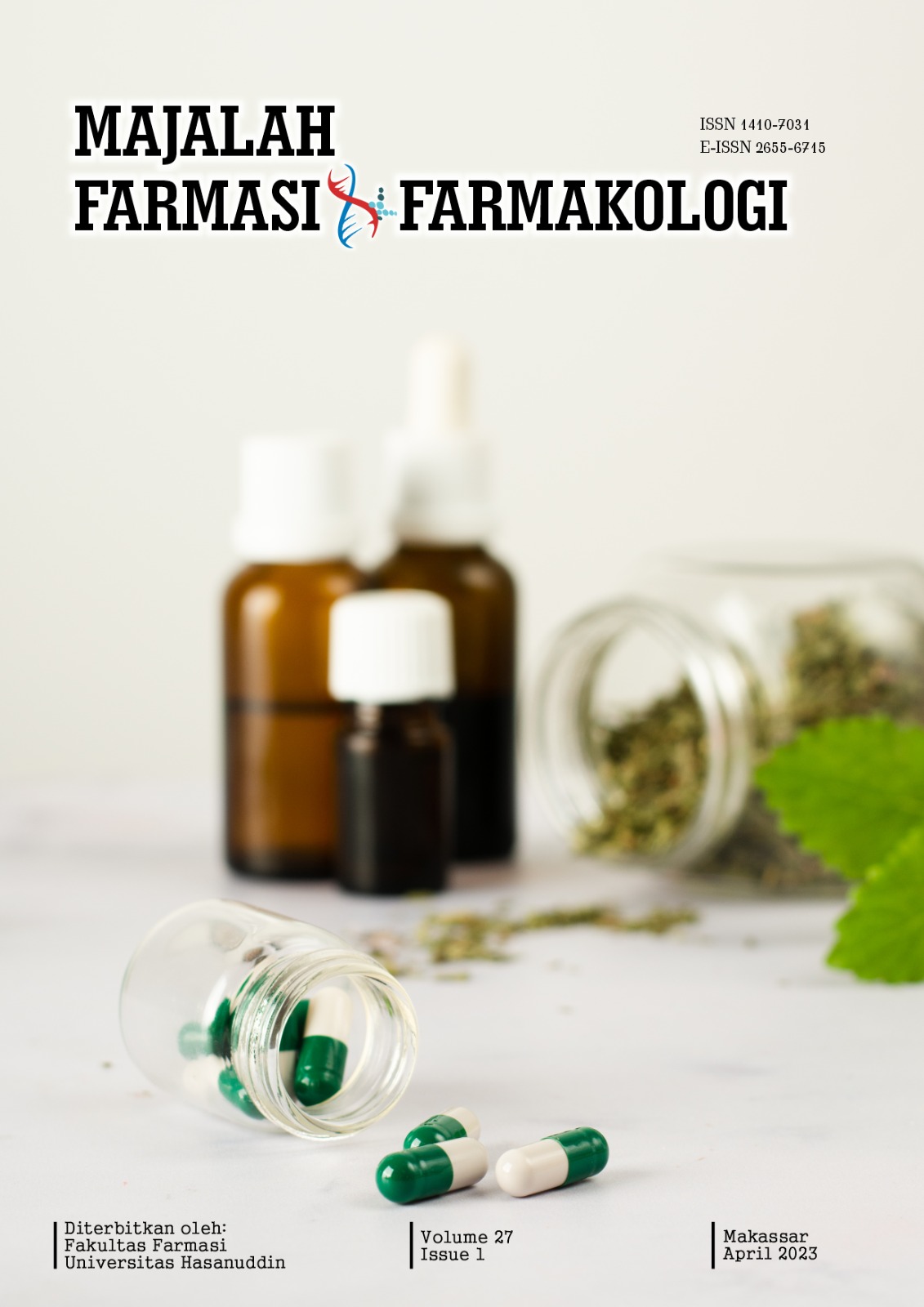Identifikasi Variasi Gen yang Bersifat Missense/Nonsense Pada Dermatomyositis Dengan Memanfaatkan Database Genomik Dan Bioinformatik
Keywords:
Dermatomyositis, autoimun, penyakit langka, variasi gen, Dermatomyositis, autoimun, penyakit langka, variasi gen, snp, missenseAbstract
Dermatomyositis merupakan penyakit autoimun yang termasuk jenis idiopatik inflamasi miopati (IIM), penyakit ini dapat mempengaruhi kulit dan otot manusia. Gejala klinis Dermatomyositis pada sebagian besar pasien adalah kelemahan otot tubuh, ruam kulit dan kulit bersisik. Salah satu faktor penyebab Dermatomyositis yang sering dilaporkan adalah faktor genetik. Hingga kini, penelitian terkait Dermatomyositis masih terbatas pada identifikasi jenis variasi gen yang mempengaruhi, namun tidak melaporkan variasi gen mana yang paling berkontribusi pada Dermatomyositis khususnya yang bersifat missense/nonsense. Sehingga pada penelitian ini kami memanfaatkan database genomik dan analisis bioinformatik untuk mengidentifikasi variasi gen yang paling berhubungan dengan penyakit Dermatomyositis. Penelitian ini menggunakan beberapa database, termasuk GWAS catalog, PheWAS catalog, HaploReg (v41.), dan GTEx portal. Hasil dari penelitian ini ditemukan bahwa gen ZBP1 berkaitan erat dengan penyakit Dermatomyositis dan menunjukkan ekpresi yang tinggi pada beberapa jaringan seperti paru-paru, lambung, esophagus, kulit, jantung dan otot. Variasi gen berdasarkan frekuensi varian alel (rs59626664, rs60542959, rs2066807, rs1048661, rs745400, rs2305480, rs2305479) terkait Dermatomyositis menunjukkan ekspresi jaringan tertinggi di kulit suprapubic, kulit dibawah lengan, otot rangka, dan esofagus. Penelitian ini menekankan bahwa integrasi database genomik dan analisis bioinformatik menunjukkan variasi gen yang berperan dalam patogenesis Dermatomyositis khususnya yang bersifat missense/nonsense. Kami menyarankan untuk peneliti selanjutnya untuk fokus pada variasi gen tersebut untuk divalidasi di fase klinis khusunya di populasi Indonesia.References
A.R. Afief, L.M. Irham, W. Adikusuma, D.A. Perwitasari, A. Brahmadhi, R. Cheung. Integration of genomic variants and bioinformatic-based approach to drive drug repurposing for multiple sclerosis. Biochem.Biophys.Rep., 32 (2022), Article 101337, 10.1016/j.bbrep.2022.101337
Bendewald, M. J., Wetter, D. A., Li, X., & Davis, M. D. P. (2010). Incidence of dermatomyositis and clinically amyopathic dermatomyositis: A population-based study in Olmsted County, Minnesota. Archives of Dermatology, 146(1), 26–30. https://doi.org/10.1001/archdermatol.2009.328
Burbelo, P. D., Ambatipudi, K., & Alevizos, I. (2014). Genome-wide association studies in Sjögren’s syndrome: What do the genes tell us about disease pathogenesis? Autoimmunity Reviews, 13(7), 756–761. https://doi.org/10.1016/j.autrev.2014.02.002
Bush, W. S., & Moore, J. H. (2012). Chapter 11: Genome-Wide Association Studies. PLoS Computational Biology, 8(12). https://doi.org/10.1371/journal.pcbi.1002822
Ciccacci, C., Latini, A., Perricone, C., Conigliaro, P., Colafrancesco, S., Ceccarelli, F., Priori, R., Conti, F., Perricone, R., Novelli, G., & Borgiani, P. (2019). TNFAIP3 gene polymorphisms in three common autoimmune diseases: Systemic lupus erythematosus, rheumatoid arthritis, and primary sjogren syndrome - association with disease susceptibility and clinical phenotypes in Italian patients. Journal of Immunology Research, 2019. https://doi.org/10.1155/2019/6728694
Chao, K. L., Kulakova, L., & Herzberg, O. (2017). Gene polymorphism linked to increased asthma and IBD risk alters gasdermin-B structure, a sulfatide and phosphoinositide binding protein. Proceedings of the National Academy of Sciences of the United States of America, 114(7), E1128–E1137. https://doi.org/10.1073/pnas.1616783114
Dourmishev, A. L., & Dourmishev, L. A. (1999). Dermatomyositis and drugs. Advances in Experimental Medicine and Biology, 455, 187–191. https://doi.org/10.1007/978-1-4615-4857-7_27
Deakin, C. T., Bowes, J., Rider, L. G., Miller, F. W., Pachman, L. M., Sanner, H., . . . the Myositis Genetics, C. (2022). Association with HLA-DRβ1 position 37 distinguishes juvenile dermatomyositis from adult-onset myositis. Human Molecular Genetics, 31(14), 2471-2481. doi:10.1093/hmg/ddac019
Fadista, J., Manning, A. K., Florez, J. C., & Groop, L. (2016). The (in)famous GWAS P-value threshold revisited and updated for low-frequency variants. European Journal of Human Genetics, 24(8), 1202–1205. https://doi.org/10.1038/ejhg.2015.269
Huang, C. M., Huang, P. H., Chen, C. L., Lin, Y. J., Tsai, C. H., Huang, W. L., & Tsai, F. J. (2012). Association of toll-like receptor 9 gene polymorphism in Chinese patients with systemic lupus erythematosus in Taiwan. Rheumatology International, 32(7), 2105–2109. https://doi.org/10.1007/s00296-011-1925-8
Lener, M. S. (2016). Triggers of Inflammatory Myopathy: Insights into Pathogenesis. Physiology & Behavior, 176(1), 139–148.
Lin, F. R., Niparko, J. K., & Ferrucci, and L. (2014). Dermatomyosititis. Bone, 23(1), 1–7. https://doi.org/10.1159/000131751.Dermatomyositis
L.M. Irham, W. Adikusuma, D.A. Perwitasari, H. Dania, R. Maliza, I.N. Faridah, I.N. Santri, Y.V.A. Phiri, R. Cheung. The use of genomic variants to drive drug repurposing for chronic hepatitis B. Biochem.Biophys.Rep., 31 (2022), Article 101307, 10.1016/j.bbrep.2022.101307
L.M. Irham, H.S.-C. Wong, W.-H. Chou, W. Adikusuma, E. Mugiyanto, W.-C. Huang, W.-C. Chang. Integration of genetic variants and gene network for drug repurposing in colorectal cancer. Pharmacol. Res., 161 (2020), Article 105203, 10.1016/j.phrs.2020.105203
L.M. Irham, W. Adikusuma, D.A. Perwitasari. Genomic variants-driven drug repurposing for tuberculosis by utilizing the established bioinformatic-based approach. Biochem.Biophys.Rep., 32 (2022), Article 101334, 10.1016/j.bbrep.2022.101334
Moffatt, M. F., Gut, I. G., Demenais, F., Strachan, D. P., Bouzigon, E., Heath, S., … Cookson, W. O. C. M. (2010). A Large-Scale, Consortium-Based Genomewide Association Study of Asthma. New England Journal of Medicine, 363(13), 1211–1221. https://doi.org/10.1056/nejmoa0906312
O’Hanlon, T. P., Carrick, D. M., Arnett, F. C., Reveille, J. D., Carrington, M., Gao, X., Oddis, C. V., Morel, P. A., Malley, J. D., Malley, K., Dreyfuss, J., Shamim, E. A., Rider, L. G., Chanock, S. J., Foster, C. B., Bunch, T., Plotz, P. H., Love, L. A., & Miller, F. W. (2005). Immunogenetic risk and protective factors for the idiopathic inflammatory myopathies: Distinct HLA-A, -B, -Cw, -DRB1 and -DQA1 allelic profiles and motifs define clinicopathologic groups in Caucasians. Medicine, 84(6), 338–349. https://doi.org/10.1097/01.md.0000189818.63141.8c
Okogbaa, J., & Batiste, L. (2019). Dermatomyositis: An Acute Flare and Current Treatments. Clinical Medicine Insights: Case Reports, 12. https://doi.org/10.1177/1179547619855370
Pendergrass, S. A., Dudek, S. M., Crawford, D. C., & Ritchie, M. D. (2012). Visually integrating and exploring high throughput Phenome-Wide Association Study (PheWAS) results using PheWAS-View. BioData Mining, 5(1), 1. https://doi.org/10.1186/1756-0381-5-5
Sontheimer, R. D. (2002). Dermatomyositis: An overview of recent progress with emphasis on dermatologic aspects. Dermatologic Clinics, 20(3), 387–408. https://doi.org/10.1016/S0733-8635(02)00021-9
Takaoka, A., Wang, Z., Choi, M. K., Yanai, H., Negishi, H., Ban, T., Lu, Y., Miyagishi, M., Kodama, T., Honda, K., Ohba, Y., & Taniguchi, T. (2007). DAI (DLM-1/ZBP1) is a cytosolic DNA sensor and an activator of innate immune response. Nature, 448(7152), 501–505. https://doi.org/10.1038/nature06013
Takaoka, A., Wang, Z., Choi, M. K., Yanai, H., Negishi, H., Ban, T., Lu, Y., Miyagishi, M., Kodama, T., Honda, K., Ohba, Y., & Taniguchi, T. (2016). ZBP1/DAI is an innate sensor of influenza virus triggering the NLRP3 inflammasome and programmed cell death pathways. Physiology & Behavior, 176(3), 139–148. https://doi.org/10.1126/sciimmunol.aag2045.ZBP1/DAI
The GTEx Consortium. (2013). The Genotype-Tissue Expression (GTEx) project The GTEx Consortium* Abstract. Database: National Center for Biomedical Information, 45(6), 580–585. https://doi.org/10.1038/ng.2653.The
Ward, L. D., & Kellis, M. (2016). HaploReg v4: Systematic mining of putative causal variants, cell types, regulators and target genes for human complex traits and disease. Nucleic Acids Research, 44(D1), D877–D881. https://doi.org/10.1093/nar/gkv1340
Zhang, Z., Miteva, M. A., Wang, L., & Alexov, E. (2012). Analyzing effects of naturally occurring missense mutations. Computational and Mathematical Methods in Medicine, 2012. https://doi.org/10.1155/2012/805827
Downloads
Published
Issue
Section
License
Copyright (c) 2023 Majalah Farmasi dan Farmakologi

This work is licensed under a Creative Commons Attribution-NonCommercial 4.0 International License.
The copyright to this article is transferred to Universitas Hasanuddin (UNHAS) if and when the article is accepted for publication. The undersigned hereby transfers all rights in and to the paper including without limitation all copyrights to UNHAS. The undersigned hereby represents and warrants that the paper is original and that he/she is the author of the paper, except for material that is clearly identified as to its original source, with permission notices from the copyright owners where required. The undersigned represents that he/she has the power and authority to make and execute this assignment.
We declare that:
- This paper has not been published in the same form elsewhere.
- It will not be submitted anywhere else for publication prior to acceptance/rejection by this Journal.
- A copyright permission is obtained for materials published elsewhere and which require this permission for reproduction.
Furthermore, I/We hereby transfer the unlimited rights of publication of the above-mentioned paper in whole to UNHAS The copyright transfer covers the exclusive right to reproduce and distribute the article, including reprints, translations, photographic reproductions, microform, electronic form (offline, online) or any other reproductions of similar nature.
The corresponding author signs for and accepts responsibility for releasing this material on behalf of any and all co-authors. This agreement is to be signed by at least one of the authors who have obtained the assent of the co-author(s) where applicable. After submission of this agreement signed by the corresponding author, changes of authorship or in the order of the authors listed will not be accepted.


